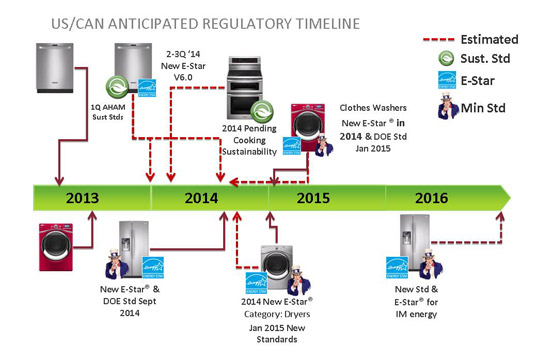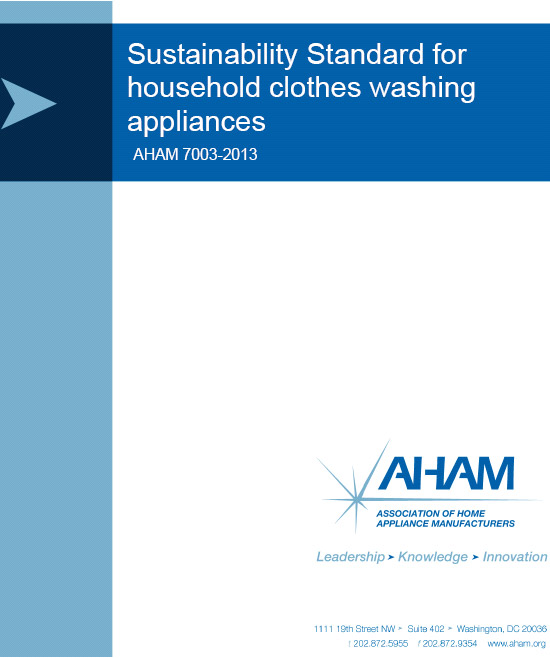Appliance Performance beyond ENERGY STAR®
This is because a 2013 ENERGY STAR® refrigerator needed to be 20% more efficient than the federal standard in effect in 2013 to qualify. The new 2014 federal standard meets or exceeds the prior (2013) ENERGY STAR® threshold at 20 to 30 percent more efficient than the previous 2013 federal standard. While this sounds like large gains, the absolute energy use (measured in terms of kilowatt hours) has been reduced dramatically since the 1970s. The 2014 ENERGY STAR® update could amount to a calculated average of only $6 per year difference in energy use between a 2014 ENERGY STAR® refrigerator and a comparable 2014 federal standard refrigerator. Recognizing this diminishing absolute amount of energy available to be saved, the 2014 ENERGY STAR® label (Version 5.0 for Residential Refrigerators and Freezers) can now be earned for a refrigerator that uses only 10 percent less energy than the 2014 federal standard.
In addition to product category updates in the ENERGY STAR® program, new product categories have also been added over time while some products still remain outside the purview of the program. For example, refrigerators, clothes washers and dishwashers are some of the appliance categories that have been eligible to apply for an ENERGY STAR® label, but cooking appliances and clothes dryers are not currently covered under the program. A clothes dryer standard is under development and may be available in 2015.
AHAM Sustainability Standards
The Association of Home Appliance Manufacturers (AHAM) is an appliance industry trade association representing manufacturers of major, portable and floor care home appliances, and suppliers to the industry throughout the U.S. and Canada. Altogether, AHAM boasts a membership of over 150 companies located throughout the world. In addition, AHAM is also a standards development organization, accredited by the American National Standards Institute (ANSI). In that role, it has authored numerous appliance performance testing standards used by manufacturers, consumer organizations and governmental bodies to rate and compare appliances.
In recent years, AHAM has embarked on a broad Product Sustainability Initiative with the overall goal to provide meaningful product sustainability information to consumers, their member companies, and other stakeholders. Their stated intention for this initiative is to drive innovation and continual improvement in the sustainability performance of home appliances by empowering consumers with information and knowledge. To date, they have produced first editions of two completely voluntary, consensus based Sustainability Standards – one for refrigerators and one for clothes washers with others planned or in the works.
 |
A summary of the updated and changing nature of standards related to different household appliances between 2013 and 2015. Image courtesy of Whirlpool Corporation |
Refrigerators. The Sustainability Standard for Household Refrigeration Appliances was first published in June of 2012 and was produced as a joint effort between AHAM, Canadian Standards Association (operating as CSA Group), and Underwriters Laboratories (UL). Because of this tri-party development and publication, the standard is cited as AHAM 7001-2012/ CSA SPE-7001.12/ UL 7001. It recognizes that the environmental performance of refrigeration home appliances has commonly been evaluated on the single environmental attribute of electricity consumption during use. This Standard was intentionally developed using life cycle thinking with a broader, multi-attribute, and more holistic approach to assess the environmental impacts of refrigeration home appliances using life-cycle assessment (LCA) data along with other key factors. Eligible refrigeration products can be evaluated for their sustainability under this standard based on six attributes each of which provides points that can be awarded through a combination of prerequisite and optional point items as follows: (note that the first five attributes are required; Item (f), innovation, is a bonus attribute, and is therefore not required):

For refrigeration appliances to be considered as having some level of recognized environmental performance under this Standard, such appliances shall
(a.) Receive a minimum total of 60 points.
(b.) Meet ENERGY STAR® performance criteria within the attribute of “energy consumption during use”.
(c.) Meet the requirements of the product performance attribute.
(d.) Show a balanced manner of reaching the 60 point level such that some points are attained in each of the 5 required attributes (i.e. items (a.) – (e.) above).
Full details of all aspects of the definitions, prerequisites, requirements, and testing of household refrigeration appliances is included in the full publication of the standard.
 |
The Association of Home Appliance Manufacturers (AHAM) has teamed with the CSA Group and UL to create a series of voluntary sustainability standards for appliances that address the full life cycle of those appliances. Courtesy of Whirlpool Corporation and AHAM |









